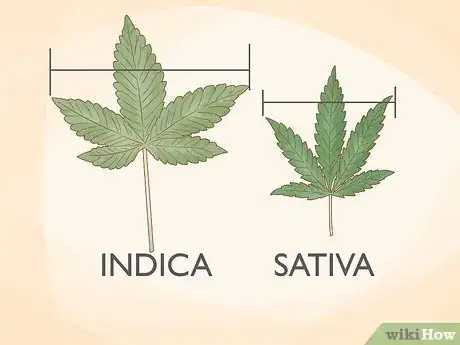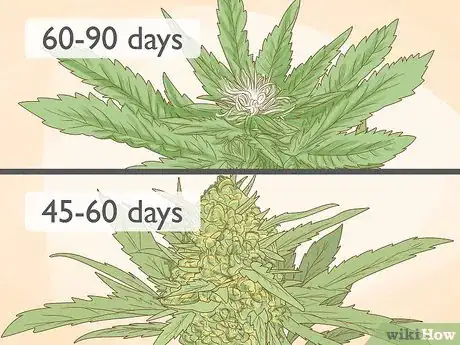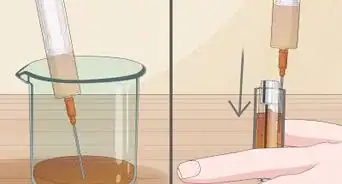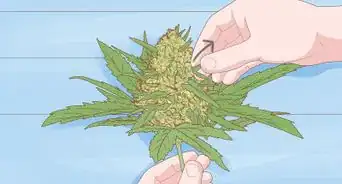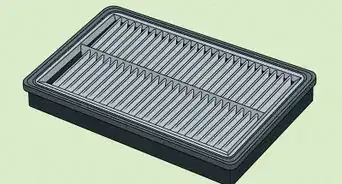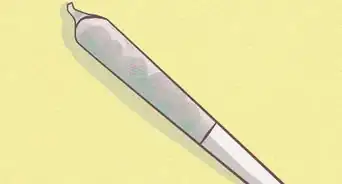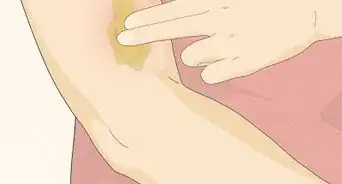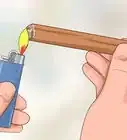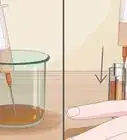This article was co-authored by Jamie Corroon, ND, MPH and by wikiHow staff writer, Jennifer Mueller, JD. Dr. Jamie Corroon, ND, MPH is the founder and Medical Director of the Center for Medical Cannabis Education. Dr. Corroon is a licensed Naturopathic Doctor and clinical researcher. In addition to clinical practice, Dr. Corroon advises dietary supplement and cannabis companies regarding science, regulation, and product development. He is well published in the peer-review literature, with recent publications that investigate the clinical and public health implications of the broadening acceptance of cannabis in society. He earned a Masters in Public Health (MPH) in Epidemiology from San Diego State University. He also earned a Doctor of Naturopathic Medicine degree from Bastyr University, subsequently completed two years of residency at the Bastyr Center for Natural Health, and is a former adjunct professor at Bastyr University California.
There are 12 references cited in this article, which can be found at the bottom of the page.
This article has been viewed 58,237 times.
If marijuana is legal where you live and you've ever stepped inside a dispensary, you might've been overwhelmed by the sheer number of different strains available. All these strains can be split into 2 main types: indica, which is more of a downer, and sativa, which is more of an upper.[1] As it turns out, the 2 types are different in a lot of different ways. Here, we've gathered different attributes you can use to tell indica and sativa apart, whether you're smoking them, looking at a jar of buds, or walking through a cultivation center.
Steps
Expert Q&A
-
QuestionIs hemp or CBD better for pain?
 Jamie Corroon, ND, MPHDr. Jamie Corroon, ND, MPH is the founder and Medical Director of the Center for Medical Cannabis Education. Dr. Corroon is a licensed Naturopathic Doctor and clinical researcher. In addition to clinical practice, Dr. Corroon advises dietary supplement and cannabis companies regarding science, regulation, and product development. He is well published in the peer-review literature, with recent publications that investigate the clinical and public health implications of the broadening acceptance of cannabis in society. He earned a Masters in Public Health (MPH) in Epidemiology from San Diego State University. He also earned a Doctor of Naturopathic Medicine degree from Bastyr University, subsequently completed two years of residency at the Bastyr Center for Natural Health, and is a former adjunct professor at Bastyr University California.
Jamie Corroon, ND, MPHDr. Jamie Corroon, ND, MPH is the founder and Medical Director of the Center for Medical Cannabis Education. Dr. Corroon is a licensed Naturopathic Doctor and clinical researcher. In addition to clinical practice, Dr. Corroon advises dietary supplement and cannabis companies regarding science, regulation, and product development. He is well published in the peer-review literature, with recent publications that investigate the clinical and public health implications of the broadening acceptance of cannabis in society. He earned a Masters in Public Health (MPH) in Epidemiology from San Diego State University. He also earned a Doctor of Naturopathic Medicine degree from Bastyr University, subsequently completed two years of residency at the Bastyr Center for Natural Health, and is a former adjunct professor at Bastyr University California.
Medical Director of the Center for Medical Cannabis Education CBD is most commonly used to reduce pain and improve sleep, while hemp oil is primarily used to supplement one’s diet with important fatty acids that may reduce inflammation.
CBD is most commonly used to reduce pain and improve sleep, while hemp oil is primarily used to supplement one’s diet with important fatty acids that may reduce inflammation. -
QuestionDoes topical CBD actually work?
 Jamie Corroon, ND, MPHDr. Jamie Corroon, ND, MPH is the founder and Medical Director of the Center for Medical Cannabis Education. Dr. Corroon is a licensed Naturopathic Doctor and clinical researcher. In addition to clinical practice, Dr. Corroon advises dietary supplement and cannabis companies regarding science, regulation, and product development. He is well published in the peer-review literature, with recent publications that investigate the clinical and public health implications of the broadening acceptance of cannabis in society. He earned a Masters in Public Health (MPH) in Epidemiology from San Diego State University. He also earned a Doctor of Naturopathic Medicine degree from Bastyr University, subsequently completed two years of residency at the Bastyr Center for Natural Health, and is a former adjunct professor at Bastyr University California.
Jamie Corroon, ND, MPHDr. Jamie Corroon, ND, MPH is the founder and Medical Director of the Center for Medical Cannabis Education. Dr. Corroon is a licensed Naturopathic Doctor and clinical researcher. In addition to clinical practice, Dr. Corroon advises dietary supplement and cannabis companies regarding science, regulation, and product development. He is well published in the peer-review literature, with recent publications that investigate the clinical and public health implications of the broadening acceptance of cannabis in society. He earned a Masters in Public Health (MPH) in Epidemiology from San Diego State University. He also earned a Doctor of Naturopathic Medicine degree from Bastyr University, subsequently completed two years of residency at the Bastyr Center for Natural Health, and is a former adjunct professor at Bastyr University California.
Medical Director of the Center for Medical Cannabis Education Yes, but these products do not drive CBD deep enough into the body to reach the bloodstream. As a result, it is unlikely that this method of administration would help with things like anxiety, seizures, sleep problems and other symptoms or medical conditions.
Yes, but these products do not drive CBD deep enough into the body to reach the bloodstream. As a result, it is unlikely that this method of administration would help with things like anxiety, seizures, sleep problems and other symptoms or medical conditions.
Warnings
- Cannabis is illegal in many places.[22] Check local laws before you buy cannabis or carry any with you from one place to another to avoid possible criminal penalties.[23]⧼thumbs_response⧽
- Marijuana sold in dispensaries is much more potent than marijuana sold before legalization. Go slow and don't overdo it, especially if you're just getting started.[24]⧼thumbs_response⧽
- This article discusses the difference between pure indica and sativa strains. Most of the cannabis sold in dispensaries are hybrid strains, so the differences might not be as profound.[25]⧼thumbs_response⧽
- Customer service representatives should be knowledgeable and formally trained, but it is important to remember that they should not provide medical advice. Be wary of sales representatives that act like healthcare professionals and make therapeutic claims about products. In case of any questions, you should consult a knowledgeable healthcare professional.[26]⧼thumbs_response⧽
- In some states, you should be qualified to purchase medicinal marijuana. A visit with a healthcare professional who is evaluating patients for a state medical marijuana program should be treated like any other visit to a healthcare provider.[27]⧼thumbs_response⧽
References
- ↑ https://www.coloradoan.com/story/sponsor-story/choice-organics/2019/03/15/know-your-bud-key-differences-between-sativa-indica-and-hybrid-cannabis/3131311002/
- ↑ https://www.leafly.com/news/cannabis-101/sativa-indica-and-hybrid-differences-between-cannabis-types
- ↑ https://www.leafly.com/news/strains-products/what-is-kush-marijuana
- ↑ https://www.mic.com/articles/173973/indica-vs-sativa-what-s-the-difference-how-to-identify-them-and-which-is-better-for-you
- ↑ https://www.clovrcannabis.com/blog/difference-between-indica-sativa
- ↑ Jamie Corroon, ND, MPH. Medical Director of the Center for Medical Cannabis Education. Expert Interview. 10 March 2020.
- ↑ https://greenleafmc.ca/our-learning-centre/sativa-vs-indica
- ↑ Jamie Corroon, ND, MPH. Medical Director of the Center for Medical Cannabis Education. Expert Interview. 10 March 2020.
- ↑ https://greenleafmc.ca/our-learning-centre/sativa-vs-indica
- ↑ https://www.cnbs.org/cannabis-types/sativa-vs-indica/
- ↑ Jamie Corroon, ND, MPH. Medical Director of the Center for Medical Cannabis Education. Expert Interview. 10 March 2020.
- ↑ https://greenleafmc.ca/our-learning-centre/sativa-vs-indica
- ↑ https://www.cnbs.org/cannabis-types/sativa-vs-indica/
- ↑ Jamie Corroon, ND, MPH. Medical Director of the Center for Medical Cannabis Education. Expert Interview. 10 March 2020.
- ↑ Jamie Corroon, ND, MPH. Medical Director of the Center for Medical Cannabis Education. Expert Interview. 10 March 2020.
- ↑ https://wayofleaf.com/cannabis/101/differences-between-indica-and-sativa-strains
- ↑ https://wayofleaf.com/cannabis/101/differences-between-indica-and-sativa-strains
- ↑ https://thesourcenv.com/know-your-cannabis-eight-differences-between-indica-and-sativa/
- ↑ https://wayofleaf.com/cannabis/101/differences-between-indica-and-sativa-strains
- ↑ https://www.cnbs.org/cannabis-types/sativa-vs-indica/
- ↑ Jamie Corroon, ND, MPH. Medical Director of the Center for Medical Cannabis Education. Expert Interview. 10 March 2020.
- ↑ Jamie Corroon, ND, MPH. Medical Director of the Center for Medical Cannabis Education. Expert Interview. 10 March 2020.
- ↑ https://www.chicagotribune.com/marijuana/sns-tft-liststory-cannabis-laws-around-the-world-20210715-n6bdtyofrnaddj7x4ipiesmxdq-list.html
- ↑ https://www.cnbs.org/health/
- ↑ https://www.clovrcannabis.com/blog/difference-between-indica-sativa
- ↑ Jamie Corroon, ND, MPH. Medical Director of the Center for Medical Cannabis Education. Expert Interview. 10 March 2020.
- ↑ Jamie Corroon, ND, MPH. Medical Director of the Center for Medical Cannabis Education. Expert Interview. 10 March 2020.









